简体中文
繁體中文
English
Pусский
日本語
ภาษาไทย
Tiếng Việt
Bahasa Indonesia
Español
हिन्दी
Filippiiniläinen
Français
Deutsch
Português
Türkçe
한국어
العربية
The Importance of Order Flow in Forex Trading
Abstract:By understanding order flow, traders can better anticipate price movements. They can also make more informed trading decisions.

In order to be successful in forex trading, it is important to understand the concept of order flow. This involves understanding how buyers and sellers interact to create price movement. By understanding order flow, traders can better anticipate price movements and make more informed trading decisions.
Take Advantage of the Biggest Financial Event in London. This year we have expanded to new verticals in Online Trading, Fintech, Digital Assets, Blockchain, and Payments.
Forex Trading and the Order Flow
The spot foreign exchange market is the most traded financial market in the world, with a daily trading volume that can reach $6.6 trillion. Each time you enter an order on an online trading platform, the order will go through electronically. Some large trading orders may then be completed through verbal negotiation (inter-dealer brokerage).
For example, a Citibank trader wants to sell 200 million euros, in order to fill the order at the best price as soon as possible, the Citi trader needs to split the 200 million euros into several orders, ask for quotes from market makers such as JP Morgan, UBS or Goldman Sachs, negotiate to the best price and then fill the order one by one.
As you can see, the execution of large orders are generally interbank market institutions.
Some brokers who provide trading intermediary services to individual traders also participate in order executions, becoming buyers or sellers of orders. Examples of such large forex brokers are PCS, Goldman Sachs, CMC Markets or IG, as they themselves are able to get the best liquidity quotes from banks.
Brokers mainly offer their services to individual traders, and they also keep records of order flow. Order flow is generated when buyers and sellers in the forex marketplace place their intended orders. Order flow can be valuable to market makers or other types of brokers because it reflects the potential momentum of a currency pair's movement.
Order flow for foreign exchange trading comes primarily from the interbank market, which generates almost half of the global foreign exchange trading order flow on a daily basis. Since the liquidity of the foreign exchange market is basically achieved through the interbank market, it is necessary to study how these interbank institutional participants use order flow information to make trading decisions.

What Is Order Flow?
Financial institutions, such as banks, typically have a large number of clients around the world who may then have a need for foreign exchange trading. These financial institutions are, therefore, very active in markets such as interest rates and commodities, and they can act as intermediaries, brokering orders between buyers and sellers, thus generating order flow.
The key to trading with order flow is to determine the 'market depth' / 'depth of market' (DOM). The 'market depth' reflects the deep order information in the forex market, as well as the level of exchange rates at which customers are willing to trade.
Order flow is similar to an order list that follows market fluctuations. Institutional clients of banks usually don't care about every bit of price movement, they just choose an appropriate price level for traders to execute, which is equivalent to a limit order. Order flow, on the other hand, allows traders to see how much volume is being traded at a particular price level, and they then use this information to trade and generate potential profits.
The Impact of Market Order and Market Depth
For example, if you find a large number of sell orders for EUR/USD at 1.1000, it does not mean that these large sell orders will be filled, because if the exchange rate does not touch the level of 1.1000, these orders will not be filled, and the exchange rate will not fall sharply when it touches 1.1000; in addition, these orders may also be cancelled before they are filled, and after they are cancelled, the orders will not affect After cancellation, the order will not affect the exchange rate movement.
The order flow reflects all the orders of traders in the market, including the direction, price and size of orders. Many traders use order flow information to increase their trading advantage. Based on this, order flow trading is more appropriate in the futures market, as the forex market cannot see specific data such as trading volume.
Of course, this does not mean that the trader can trade in advance, as the client can cancel the trade order at any time.Using Order Flow to Determine Market Sentiment
If you are not an institutional trader, then order flow can be difficult to obtain. Most institutional traders use EBS or Thomson Reuters Dealing, platforms that allow them to develop internal order flow indicators.
In other words, when a broker has direct access to the EBS platform, he is trading directly in the primary liquidity market, at the 'deep liquidity' level, so order flow information can be viewed directly.
Order Flow in Option Market
Trading as an individual does not allow you to access the 'market depth' and order flow information. Fortunately, individual traders can refer to other markets, such as futures, ETFs, and options markets, to speculate on market sentiment.
The trading volume in the futures market reflects the overall trading of a specific contract. The liquidity of futures contracts on foreign exchange currency pairs is very high, ensuring that the currency rates in the futures market and the OTC market are consistent and preventing arbitrage activities.
If there is a sharp increase in the trading volume of futures contracts around a specific time or price level, it is likely that traders are entering the operation. The problem, however, is that you cannot know this information in advance, so you must determine whether this sharp increase in trading volume will push prices higher or weaken them.
You can also use information about open positions in the market to determine market sentiment. If the volume is greater than the amount of open positions, new orders are entering the market, indicating a more positive market sentiment. If there are no new orders entering the market, it indicates a low market sentiment.
In addition, data related to the options market is very useful and, like the futures market, can help determine the long and short market sentiment.
Conclusion
Order flow is valuable information for institutional traders and individual traders alike. Traders use forex order flow information to understand whether the market is likely to be trending or stagnant. The idea of order flow is the process of understanding the microstructure of the market from each trade, digging into the information, sentiment and real buying and selling power contrast brought by the market from the surprising trade data. However, the market is evolving and the information contained in candlesticks is gradually decreasing, so we need to put on a microscope to observe the information contained in each trade in the order book.

Disclaimer:
The views in this article only represent the author's personal views, and do not constitute investment advice on this platform. This platform does not guarantee the accuracy, completeness and timeliness of the information in the article, and will not be liable for any loss caused by the use of or reliance on the information in the article.
Read more

Charles Schwab Review: Traders Claim Illegitimate Profit Cancellation, Trade Manipulation & More
Have you been lured into the Charles Schwab app for trading on the back of outrageous profit claims by the broker? Did you fail to receive any of these? Does the broker deny withdrawals every time you request and cancel your forex trading account? Have you been victimized financially by its trade manipulation? Act before you are left with a NIL balance in your account. Many traders have questioned Charles Schwab customer service and many other operational executives for the aforementioned illegitimate trading activities. In this Charles Schwab review article, we have shared some of their comments. Read on!

AMP Futures Exposed: Traders Raise Alarms Over Illegitimate Account Blocks & Bad Customer Service
Has AMP Futures blocked your forex trading account? Does it fail to provide any explanation for this act? Do you face issues concerning deposits to your AMP Futures account? Is the customer service non-existent for any trading query you raise with it? You are not alone! Many traders have been facing these issues upon AMP Futures login. Some of them have commented on AMP Futures review platforms. In this article, we have shared some reviews that you can look at. Read on!

FXGlory Review: Vanishing Profits, Capital Scams & Withdrawal Charges Keep Annoying Traders
Does FXGlory remove all your forex trading account balances upon fund withdrawal requests? Or do you witness incorrect trading account balances after fund withdrawals? Does the Saint Lucia-based forex broker charge you for fund withdrawals? All these and many more scam-related complaints have been filed against the forex broker. In this FXGlory review article, we will discuss several complaints. Read on!

PINAKINE Broker Review: A Complete Look at Its Services and Risks
Finding a trustworthy broker from the huge and often confusing world of online trading options is one of the biggest challenges a trader faces. In this competitive market, PINAKINE Liquidity Limited has appeared, getting attention with promises of high leverage and zero-commission trading. However, a closer look shows important factors that every potential client must think about before investing. The most important thing to consider with PINAKINE is that it has no regulation. This fact completely changes how risky the broker is and has major effects on how safe your investments will be. This review gives a complete and fair examination based on information available to the public. We will break down its services, trading conditions, platform technology, and the possible risks involved, helping you make a fully informed decision.
WikiFX Broker
Latest News
Stonefort Broker Review 2025: Legit or Risky? A Complete Analysis
Quantower Review 2025: User Reviews and Complaints in India
Uniglobe Markets Review 2025: A Safe Broker or a High-Risk Scam?
CHINA BEST Broker Review: Regulation and Risks
TD Markets Exposed: Price Manipulation, Withdrawal Issues & False Promises Hurt Traders
Bank of England holds rates steady in narrow vote ahead of Autumn Budget
BingX Review: Traders Angry Over Withdrawal Denials, Account Blocks & More
Op-ed: The fuel for the AI boom driving the markets is advertising. It is also an existential risk.
Private payrolls rose 42,000 in October, more than expected and countering labor market fears, ADP says
He Thought It Was a Crypto Investment; It Cost Him RM1.2 Million
Currency Calculator




